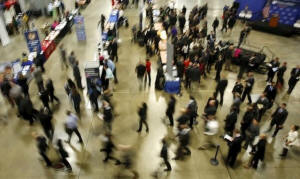|
U.S. job growth seen accelerating in
January, wages strong
 Send a link to a friend
Send a link to a friend
 [February 03, 2017]
By Lucia Mutikani [February 03, 2017]
By Lucia Mutikani
WASHINGTON (Reuters) - U.S. job growth
likely accelerated in January, with wages expected to have increased
steadily, suggesting a strong start for the Trump administration as it
seeks to boost the economy and employment.
Nonfarm payrolls probably increased by 175,000 jobs last month, in part
as warm weather bolstered hiring in the construction sector, according
to a Reuters survey of economists. That would be a pick-up from the
156,000 jobs created in December.
President Donald Trump vowed during last year's election campaign to
deliver 4 percent annual gross domestic product growth, largely on the
back of a plan to cut taxes, reduce regulations, increase infrastructure
spending and renegotiate deals in the United States' favor.
Although details on the policy proposals remain sketchy, consumer and
business confidence have surged in the wake of Trump's election victory
last November.
But with the economy near full employment, some economists are skeptical
of the 4 percent growth pledge. Annual GDP growth has not exceeded 2.6
percent since the 2007-08 recession.
"Time will tell if Trump can keep the economy's winning streak alive.
It's not going to be easy to bring back those manufacturing jobs lost
since the late '90s," said Chris Rupkey,
chief economist at MUFG Union Bank in New York.
The Labor Department will publish its closely watched employment report
on Friday at 08:30 a.m. (08:30 a.m. ET).

With the minimum wage taking effect in more than a dozen states in
January, average hourly earnings are forecast to have risen by 0.3
percent after increasing 0.4 percent in December. However, the
year-on-year gain in earnings is expected to fall to 2.8 percent from
2.9 percent in December as the jump in wages seen in January 2016 drops
out of the picture.
Rising wages could pave the way for the Federal Reserve to raise
interest rates this year. The unemployment rate is forecast unchanged at
4.7 percent.
"Solid job growth should help, in part, lead to lower unemployment and
firming wage pressures, and justify the Fed hiking interest rates twice
this year," said Sam Bullard, a senior economist at Wells Fargo
Securities in Charlotte, North Carolina.
The Fed, which hiked rates in December, has forecast three rate
increases this year. On Wednesday, the U.S. central bank kept its
benchmark overnight interest rate unchanged in a range of 0.50 percent
to 0.75 percent. It said it expected labor market conditions would
strengthen "somewhat further."
UPSIDE SURPRISE LIKELY
January payrolls could beat expectations. The ADP National Employment
Report on Wednesday showed that private employers added 246,000 jobs
last month, up from 151,000 in December. At the same time, the Institute
for Supply Management's measure of factory employment hit its highest
level since August 2014.
With its January employment report, the government will publish its
annual "benchmark" revisions and update the formulas it uses to smooth
the data for regular seasonal fluctuations. It will also incorporate new
population estimates.
[to top of second column] |

Job seekers break out to visit corporate employment personnel at a
U.S. Chamber of Commerce Foundation "Hiring Our Heroes" military job
fair in Washington January 8, 2016. REUTERS/Gary Cameron

In an early benchmark estimate last year, the government said the
level of employment in March of last year was likely 150,000 lower
than it had reported.
As the labor market nears full employment, the pool of workers is
shrinking, which is slowing job growth. Job gains averaged 180,000
per month in 2016, down from 229,000 in 2015.
The shift in population controls will mean figures on the labor
force or number of employed or unemployed in January will not be
directly comparable with December.
The labor force participation rate, or the share of working-age
Americans who are employed or at least looking for a job, has been
bouncing around near multi-decade lows, pointing to slack in the
jobs market. Some of the decline reflects demographic changes.
"I think we will hit full employment later this year," said Ryan
Sweet, a senior economist at Moody's Analytics in West Chester,
Pennsylvania. "There is still shadow slack in the jobs market. But
if we continue to create more than 100,000 jobs per month, we are
going to work through that slack."
All sectors of the economy are expected to have added jobs in
January. Manufacturing payrolls are forecast to have increased for a
second straight month as the oil-related drag on the sector eases.
Construction employment likely rebounded after being depressed by
cold weather in December.
Retail payrolls probably declined as workers hired during the
holiday season were laid off. A sharp drop is likely after
retailers, including Macy's <M.N>, Sears <SHLD.O>, American Apparel
and Abercrombie & Fitch <ANF.N> announced job cuts amid store
closures.
Department store sales are being undercut by online retailers, led
by Amazon.com <AMZN.O>.
Government employment likely increased in January for a third
straight month. Economists see no impact from a freeze on the hiring
of civilian federal government workers, which took effect on Jan. 22
- well after the survey period for nonfarm payrolls. It will hurt
job growth in the coming months.

"The actual impact, while still ambiguous, will likely be more
modest, and we estimate that it will reduce job gains by about
20,000 per month," said Daniel Silver, an economist at JPMorgan in
New York.
(Reporting by Lucia Mutikani; Editing by Dan Grebler)
[© 2017 Thomson Reuters. All rights
reserved.]
Copyright 2017 Reuters. All rights reserved. This material may not be published,
broadcast, rewritten or redistributed. |